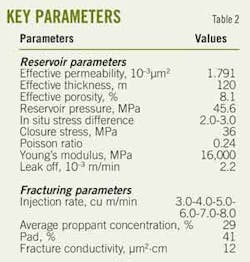Model optimizes sandstone-conglomerate fracturing in China
View Article as Single page
Field application
The optimized fracturing simulation was used first in well Y104-1. The well is at a 3,822 m depth at the Sha-4 member and had a perforation interval of 3,715-35 m.
The Sha-4 reservoir has a 8.1% porosity, 1.791 × 10–3μm2 permeability, 12.83% muddy content, and 26.185% glutenite content.
The optimized fracture parameters were designed in which the fracture half length was 145-75 m, fracture height was 145-75 m, and fracture conductivity was 10-15 μm2/cm. The design controlled the multifractures near the wellbore.
Table 2 lists the key parameters of the well. The simulation resulted in a 141.9-m fracture half length, 65.8-m fracture height, and 4.19 mm fracture width.
The formula for the polymer clean fracturing fluid was 0.9% SRCF-1 + 0.45% SRCF-1B + 0.4% SRCF-1A. In the formula SCRF-1 is a polymer gelling agent, SCR-1A is a rheological modifier for SCRF-1, and SCRF-1B is a temperature stabilizer for SCRF-1.
The fracturing fluid viscosity was greater than 70 mPa-sec after 2 hr of 170 sec–1 shearing at 150° C. From core tests, the fluid’s damage rate was about 14.71%.
The fluid had good proppant carrying and low damage characteristics that met the operational needs.
The optimized perforation interval was 3,715-35 m for the 77 m fracturing interval. The treatment included proppant densities of 1,810 kg/cu m, 1,650 kg/cu m, and 1,470 kg/cu m. Injection rates varied for 3 to 8 cu m/min.
At the beginning of fracturing, the injection rate was low to prevent generation of multifracture near the wellbore. The rate was increased step by step to generate multifractures away from the wellbore. These multifractures increased well drainage area and contacted more reserves.
A preflush slug with a small diameter ceramic proppant was for preventing fluid leakoff, cleaning the perforation holes, and reducing the risk during the high proppant concentration stage.
A high quality temporary plugging agent was pumped to plug microfracture and improve the effectiveness of the fracturing fluid.
During flowback, liquid nitrogen was injected to increase flowback rates and reduce formation damage.
A high quality antiswelling agent was included for reducing water damage.
The hydraulic fractioning of Well Y104-1 was successful, and the well produced 6,327.5 cu m of liquid and 5,253 cu m of oil within 168 days. Wellhead pressure decreased to 7.6 MPa from 27 MPa previously. Initial production rate of the well with natural flow after fracturing was 58.6 cu m/day liquid, 39.6 cu m/day oil, and 1.4 × 104 cu m of gas.
Fracture monitoring with microseismic showed that the main fracture had two wings. One wing extended southwest, the other northeast and then separated toward the north and northeast.
The fracture orientation was northeast 40°, northeast 0°, and northeast 70°. Total fracture length was more than 300 m (Fig. 5).
The microseismic involved a wave detector placed in an adjoining well.
Some lessons learned from the work were that for glutenite reservoir hydraulic fracturing, the fracturing size should be longer than usual, and that one should generate multifractures away from the wellbore and not near the wellbore.
Also the fracturing fluid needs to withstand high temperature and shearing.
The authors
Displaying 3/3
View Article as Single page
More Oil & Gas Journal Current Issue Articles
More Oil & Gas Journal Archives Issue Articles
View Oil and Gas Articles on PennEnergy.com





